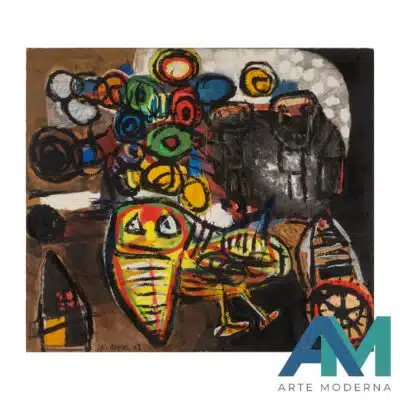Karel Appel
Artworks for sale
Biography

Karel Appel was born in Amsterdam in the Netherlands on 25 April 1921. In 1943, also in Amsterdam, he graduated from the National Academy of Fine Arts and held his first solo exhibition there in 1946. During this time, his art was influenced by Pablo Picasso (distortion of figures), Henri Matisse and the Dadaist Kurt Schwitters.
‘You have to learn all this, then forget it and start again as a child‘ – K. Appel, Conversation with Eleanor Flomenthal, in E. Flomenthal, The Roots and Developments of Cobra Art, Fine Art Museum of Long Island, 1985.
Karel Appel, the CoBrA Movement and Expressionism
Karel Appel joined the Nederlandse Experimentele Groep. In 1948, he founded the Belgian Dutch group ‘Reflex’, which merged with Constant, Corneille and Jan Nieuwenhuys (Aart Kemink) to form the CoBrA group (a term coined by the Belgian poet Christian Dotremont from the initials of the members’ countries of origin: Copenhagen, Brussels, Amsterdam).
The aim of the Expressionist movement was to oppose bourgeois naturalism, setting itself as an alternative to other groups of artists such as the de Stijl movement, in order to achieve a new representation of reality. On a formal level, the result is an aggressive painting characterised by a figurative style full of ironic and grotesque elements bordering on Jean Dubuffet’s brut (brutal) art. With a scandalous mural for Amsterdam City Hall, he had his public painting covered up for the next 10 years due to the stir it caused.
Karel Appel between expressionism and abstractionism
Having moved to Paris in 1950, it is now clear that Karel Appel’s painting moves on the borderline between expressionism and abstractionism, from large tragic portraits to mural decorations made for public buildings: for instance, the UNESCO building in the French capital.
The ferocity of the distortion of the figures, the works that captured the most brutal human emotions, the inner conflict that emulated after the real one after World War II.
In 1954 he received the UNESCO prize at the Venice Biennale. In 1957 he won a graphics prize at the Ljubljana Biennale, in 1959 a prize at the São Paulo Biennale.
Between the Fifties and Sixties
In 1962, his monograph, written by Claus, was published. During these years, he produced numerous other mural paintings for as many public buildings. From 1965 until the end of the 1970s, his style becomes less aggressive and harsh. It becomes softer and characterised by clearer and sharper images. The struggle of the past is replaced by the search for space. But already in the 1980s, Appel returned to hard, violent painting, still within the expressionist framework, even enlarging the dimensions of the paintings, following the example of neo-expressionist painting. He still uses the colours of the past, but puts them on the canvas according to a pre-ordained plan.
Appel’s work has been exhibited in numerous galleries in recent years, including the Anita Shapolsky Gallery in New York, Galerie Lelong in Paris, Galerie Ulysses in Vienna and Gallery LL in Amsterdam.
From the 1960s onwards he lived between New York and Florence. He died in Zurich, Switzerland on May 3rd, 2006.
Art of Karel Appel for sale
Biography of Karel Appel
Information request
Artwork:
Artist:

